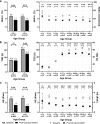Improvements in Glycemic Outcomes in 4738 Children, Adolescents, and Adults with Type 1 Diabetes Initiating a Tubeless Insulin Management System
- PMID: 36763329
- PMCID: PMC9913031
- DOI: 10.1007/s13300-023-01366-9
Improvements in Glycemic Outcomes in 4738 Children, Adolescents, and Adults with Type 1 Diabetes Initiating a Tubeless Insulin Management System
Abstract
Introduction: Despite recent advances in diabetes technology, most people living with type 1 diabetes mellitus (T1D) are unable to meet glycemic targets. Real-world evidence can provide insight into outcomes achieved with specific treatment devices when used in clinical practice. The aim of this study was to analyze real-world outcomes collected from a large cohort of people living with T1D and initiating treatment with the Omnipod DASH System.
Methods: In this retrospective observational study, real-world outcomes were analyzed from a database of information collected from people with T1D initiating the Omnipod DASH System. Information in the database was either taken directly from the patient's medical record or self-reported if medical records were unavailable. The primary outcome was change in glycated hemoglobin (HbA1c) from baseline (before initiation) to 3 months after initiation. Secondary outcomes were changes in total daily dose of insulin (TDD) and self-reported frequency of hypoglycemic events (< 70 mg/dL). Results are separated for the adult (≥ 18 years, N = 3341) and pediatric (< 18 years, N = 1397) cohorts.
Results: The change in HbA1c from baseline was - 0.9 ± 1.6% ( - 10 ± 18 mmol/mol; p < 0.0001) in adults and - 0.9 ± 2.0% ( - 10 ± 22 mmol/mol; p < 0.0001) in the pediatric cohort. For those previously using multiple daily injections, HbA1c decreased by - 1.0 ± 1.7% ( - 11 ± 19 mmol/mol) in adults and - 1.0 ± 2.1% ( - 11 ± 23 mmol/mol) in the pediatric cohort (both p < 0.0001). Hypoglycemic events decreased in adults from 2.9 to 1.3 episodes per week ( - 1.6 ± 3.2 events/week; p < 0.0001), and in the pediatric cohort from 2.8 to 1.5 episodes per week ( - 1.3 ± 2.7 events/week; p < 0.0001). In adults, TDD decreased by 19.9% (p < 0.0001), and it remained stable in the pediatric cohort (p > 0.05).
Conclusions: Real-world outcomes from this large cohort of people initiating therapy with the Omnipod DASH System showed significant improvement in HbA1c and a substantial reduction in hypoglycemic events after 3 months of use.
Keywords: CSII; HbA1c; Insulin pumps; Insulin therapy; Real-world outcomes; Type 1 diabetes.
© 2023. The Author(s).
Figures

Similar articles
-
Improved glycemic control in 3,592 adults with type 2 diabetes mellitus initiating a tubeless insulin management system.Diabetes Res Clin Pract. 2021 Apr;174:108735. doi: 10.1016/j.diabres.2021.108735. Epub 2021 Mar 9. Diabetes Res Clin Pract. 2021. PMID: 33711396
-
Efficacy of the Omnipod Insulin Management System on Glycemic Control in Patients With Type 1 Diabetes Previously Treated With Multiple Daily Injections or Continuous Subcutaneous Insulin Infusion.J Diabetes Sci Technol. 2016 Aug 22;10(5):1130-5. doi: 10.1177/1932296816638674. Print 2016 Sep. J Diabetes Sci Technol. 2016. PMID: 27290737 Free PMC article.
-
Canadian Real-World Outcomes of Omnipod Initiation in People with Type 1 Diabetes (COPPER study): Evidence from the LMC Diabetes Registry.Diabet Med. 2021 Jun;38(6):e14420. doi: 10.1111/dme.14420. Epub 2020 Oct 22. Diabet Med. 2021. PMID: 33040383 Free PMC article.
-
Real-world outcomes of Omnipod DASH system use in people with type 1 diabetes: Evidence from the Association of British Clinical Diabetologists (ABCD) study.Diabetes Res Clin Pract. 2024 Mar;209:111597. doi: 10.1016/j.diabres.2024.111597. Epub 2024 Feb 27. Diabetes Res Clin Pract. 2024. PMID: 38417535
-
Diabetes technology and treatments in the paediatric age group.Int J Clin Pract Suppl. 2011 Feb;(170):76-82. doi: 10.1111/j.1742-1241.2010.02582.x. Int J Clin Pract Suppl. 2011. PMID: 21323816 Review.
Cited by
-
Real-World Evidence Analysis of a Hybrid Closed-Loop System.J Diabetes Sci Technol. 2025 Mar;19(2):385-389. doi: 10.1177/19322968231185348. Epub 2023 Jul 8. J Diabetes Sci Technol. 2025. PMID: 37421250 Free PMC article.
-
7. Diabetes Technology: Standards of Care in Diabetes-2025.Diabetes Care. 2025 Jan 1;48(1 Suppl 1):S146-S166. doi: 10.2337/dc25-S007. Diabetes Care. 2025. PMID: 39651978 Review.
-
7. Diabetes Technology: Standards of Care in Diabetes-2024.Diabetes Care. 2024 Jan 1;47(Suppl 1):S126-S144. doi: 10.2337/dc24-S007. Diabetes Care. 2024. PMID: 38078575 Free PMC article. Review.
-
Observational Study of the Impact of Infusion Set Replacement in Insulin Pump Users on Glycemic Management.J Diabetes Sci Technol. 2025 Jun 28:19322968251345837. doi: 10.1177/19322968251345837. Online ahead of print. J Diabetes Sci Technol. 2025. PMID: 40580090 Free PMC article.
-
Initiating Insulin Pumps in Youth with New-onset Type 1 Diabetes: A Quality Improvement Initiative.Pediatr Qual Saf. 2025 Mar 19;10(2):e803. doi: 10.1097/pq9.0000000000000803. eCollection 2025 Mar-Apr. Pediatr Qual Saf. 2025. PMID: 40110444 Free PMC article.
References
-
- Cho NH, Shaw JE, Karuranga S, Huang Y, da Rocha Fernandes JD, Ohlrogge AW, et al. IDF Diabetes Atlas: global estimates of diabetes prevalence for 2017 and projections for 2045. Diabetes Res Clin Pract. 2018;138:271–81. - PubMed
-
- Tuomilehto J. The emerging global epidemic of type 1 diabetes. Curr Diab Rep. 2013;13(6):795–804. - PubMed
LinkOut - more resources
Full Text Sources

